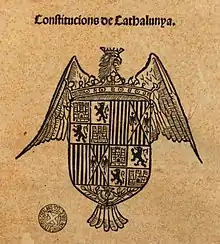| Constitutions of Catalonia Constitucions de Catalunya | |
|---|---|
 Compilation of 1702 | |
| Catalan Courts | |
| Territorial extent | Principality of Catalonia |
| Enacted by | Catalan Courts |
| Enacted | 1283 (first), 1706 (last) |
| Effective | 1283 |
| Introduced by | Count of Barcelona |
| Repealed by | |
| Nueva Planta decrees (1716) | |
| Related legislation | |
| Usages of Barcelona | |
| Catalan / Valencian cultural domain |
|---|
The Catalan constitutions (Catalan: Constitucions catalanes, IPA: [kunstitusiˈons kətəˈlanəs]) were the laws of the Principality of Catalonia promulgated by the Count of Barcelona and approved by the Catalan Courts. The Corts in Catalan have the same origin as courts in English (the sovereign's councillors or retinue) but instead meaning the legislature. The first constitutions were promulgated by the Corts of 1283. The last ones were promulgated by the Corts of 1705. They had pre-eminence over the other legal rules and could only be revoked by the Catalan Courts themselves. The compilations of the constitutions and other rights of Catalonia followed the Roman tradition of the Codex.
History
Origin: The Catalan Courts of 1283
The first Catalan constitutions were promulgated by the Catalan Courts held in Barcelona in 1283. The last ones were promulgated in 1706 by the Courts of 1705-1706 during the disputed reign of Charles III, the Habsburg pretender to the Spanish throne during the War of the Spanish Succession (1701-1713). The first compilation was prescribed by Ferdinand I of Aragon, and suggestion by the Courts held in Barcelona from 1413. It spread in edition of the 1495, together with the Usages of Barcelona:
- Usatges de Barcelona, Constitutions, Capitols, y Actes de Cort, y altras leys de Cathalunya ("Usages of Barcelona, constitutions, chapters and acts of court and other laws of Catalonia")
The compilations agreed in the Catalan Courts of 1585 and of 1702 were published in three volumes:
- Constitutions y altres drets de Cathalunya ("Constitutions and other rights of Catalonia")
- Pragmaticas y altres drets de Cathalunya ("Pragmatics and other rights of Catalonia")
- Constitutions y altres drets de Cathalunya superfluos, contraris y corregits ("Constitutions and other rights of Catalonia, superfluous, contrary, and corrected")
De jure abolition: the Nueva Planta decrees

Shortly after the end of the War of the Spanish Succession, the king Philip V of Spain from the House of Bourbon issued the set of decrees known as the Nueva Planta decrees (Spanish: Decretos de Nueva Planta, Catalan: Decrets de Nova Planta). This series of decrees abolished the separate laws of the territories that supported his Habsburg rival to the throne, the Archduke Charles of Austria; this included all realms of the Crown of Aragon. The Decretos attempted to make Spain into a centralized and absolutist monarchy on the model of France, applying the laws of Castile to all of Spain. These acts were promulgated in Valencia and Aragon in 1707, and were extended in 1716 to the Principality of Catalonia and the Balearic Islands (with the exception of Menorca, a British possession at the time).
Thus, the Catalan Constitutions were effectively abolished by the King's authority after his military victory, rather than through any legislative process within Catalonia itself. The change ignored the Catalan Constitution's own provisions for how they were to be amended or reformed.
Restoration promise: The Third Carlist War
During the Third Carlist War (1872–1876), the Carlist forces managed to occupy some cities in the Catalan interior. Isabel II was in exile and King Amadeo I had reigned since 1871, although he was not generally popular. The pretender Charles VII of Spain, grandson of Charles V of Spain (hence Carlist from Carlos, "Charles"), promised the Catalans, Valencians and Aragonese the return of their Charters or fueros (Catalan: furs) and the constitutions that Philip V had previously abolished.
The promise was never fulfilled, as the Carlist revolt did not succeed. Carlos María de los Dolores finally departed for France, 27 February 1876, the same day that Alfonso XII of Spain entered Pamplona.
See also
References
- Constitucions de Catalunya del 1495 on Wikisource.
- Furs, capítols, provisions e actes de cort fets y atorgats per la S.C.R.M. del rey don Phelip nostre senyor, ara gloriosamente regnant. Monçó, 1626 ("Fueros, chapters, provisions and acts of court made and awarded by the S.C.R.M. of King Philip our lord, who reigns gloriously") on Wikisource.
- Constitutions y altres drets de Cathalunya, Barcelona, 1704 on Wikisource.
- Chapters of the Corts of Montsó digitalized, at the Spanish Office of Culture record image (fragment referent to the Consulate of the Sea.)
External links
Principality of Catalonia
Modern Catalonia